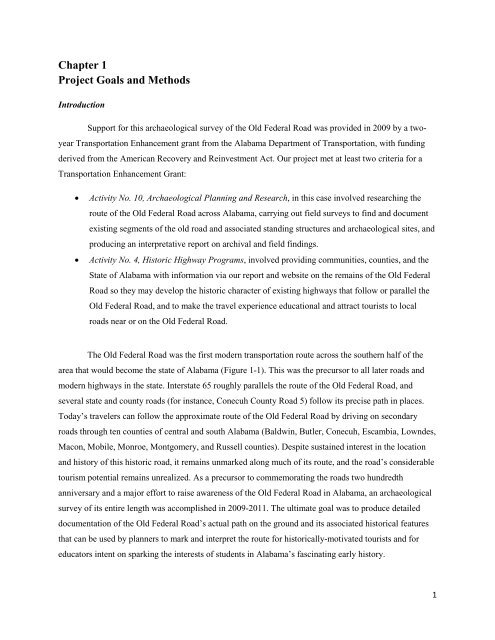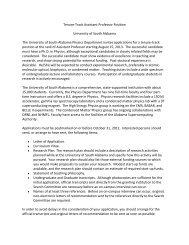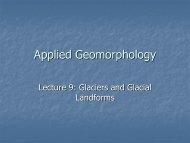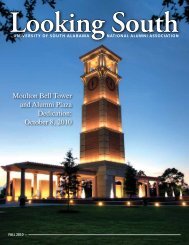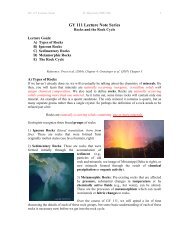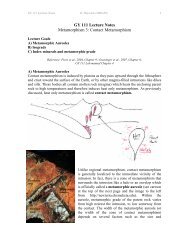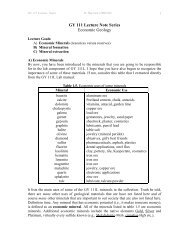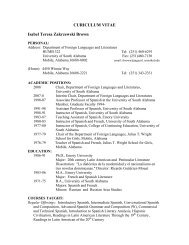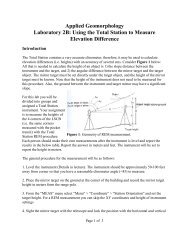Archaeological Survey of the Old Federal Road in Alabama
Archaeological Survey of the Old Federal Road in Alabama
Archaeological Survey of the Old Federal Road in Alabama
Create successful ePaper yourself
Turn your PDF publications into a flip-book with our unique Google optimized e-Paper software.
Chapter 1Project Goals and MethodsIntroductionSupport for this archaeological survey <strong>of</strong> <strong>the</strong> <strong>Old</strong> <strong>Federal</strong> <strong>Road</strong> was provided <strong>in</strong> 2009 by a twoyearTransportation Enhancement grant from <strong>the</strong> <strong>Alabama</strong> Department <strong>of</strong> Transportation, with fund<strong>in</strong>gderived from <strong>the</strong> American Recovery and Re<strong>in</strong>vestment Act. Our project met at least two criteria for aTransportation Enhancement Grant:• Activity No. 10, <strong>Archaeological</strong> Plann<strong>in</strong>g and Research, <strong>in</strong> this case <strong>in</strong>volved research<strong>in</strong>g <strong>the</strong>route <strong>of</strong> <strong>the</strong> <strong>Old</strong> <strong>Federal</strong> <strong>Road</strong> across <strong>Alabama</strong>, carry<strong>in</strong>g out field surveys to f<strong>in</strong>d and documentexist<strong>in</strong>g segments <strong>of</strong> <strong>the</strong> old road and associated stand<strong>in</strong>g structures and archaeological sites, andproduc<strong>in</strong>g an <strong>in</strong>terpretative report on archival and field f<strong>in</strong>d<strong>in</strong>gs.• Activity No. 4, Historic Highway Programs, <strong>in</strong>volved provid<strong>in</strong>g communities, counties, and <strong>the</strong>State <strong>of</strong> <strong>Alabama</strong> with <strong>in</strong>formation via our report and website on <strong>the</strong> rema<strong>in</strong>s <strong>of</strong> <strong>the</strong> <strong>Old</strong> <strong>Federal</strong><strong>Road</strong> so <strong>the</strong>y may develop <strong>the</strong> historic character <strong>of</strong> exist<strong>in</strong>g highways that follow or parallel <strong>the</strong><strong>Old</strong> <strong>Federal</strong> <strong>Road</strong>, and to make <strong>the</strong> travel experience educational and attract tourists to localroads near or on <strong>the</strong> <strong>Old</strong> <strong>Federal</strong> <strong>Road</strong>.The <strong>Old</strong> <strong>Federal</strong> <strong>Road</strong> was <strong>the</strong> first modern transportation route across <strong>the</strong> sou<strong>the</strong>rn half <strong>of</strong> <strong>the</strong>area that would become <strong>the</strong> state <strong>of</strong> <strong>Alabama</strong> (Figure 1-1). This was <strong>the</strong> precursor to all later roads andmodern highways <strong>in</strong> <strong>the</strong> state. Interstate 65 roughly parallels <strong>the</strong> route <strong>of</strong> <strong>the</strong> <strong>Old</strong> <strong>Federal</strong> <strong>Road</strong>, andseveral state and county roads (for <strong>in</strong>stance, Conecuh County <strong>Road</strong> 5) follow its precise path <strong>in</strong> places.Today’s travelers can follow <strong>the</strong> approximate route <strong>of</strong> <strong>the</strong> <strong>Old</strong> <strong>Federal</strong> <strong>Road</strong> by driv<strong>in</strong>g on secondaryroads through ten counties <strong>of</strong> central and south <strong>Alabama</strong> (Baldw<strong>in</strong>, Butler, Conecuh, Escambia, Lowndes,Macon, Mobile, Monroe, Montgomery, and Russell counties). Despite susta<strong>in</strong>ed <strong>in</strong>terest <strong>in</strong> <strong>the</strong> locationand history <strong>of</strong> this historic road, it rema<strong>in</strong>s unmarked along much <strong>of</strong> its route, and <strong>the</strong> road’s considerabletourism potential rema<strong>in</strong>s unrealized. As a precursor to commemorat<strong>in</strong>g <strong>the</strong> roads two hundredthanniversary and a major effort to raise awareness <strong>of</strong> <strong>the</strong> <strong>Old</strong> <strong>Federal</strong> <strong>Road</strong> <strong>in</strong> <strong>Alabama</strong>, an archaeologicalsurvey <strong>of</strong> its entire length was accomplished <strong>in</strong> 2009-2011. The ultimate goal was to produce detaileddocumentation <strong>of</strong> <strong>the</strong> <strong>Old</strong> <strong>Federal</strong> <strong>Road</strong>’s actual path on <strong>the</strong> ground and its associated historical featuresthat can be used by planners to mark and <strong>in</strong>terpret <strong>the</strong> route for historically-motivated tourists and foreducators <strong>in</strong>tent on spark<strong>in</strong>g <strong>the</strong> <strong>in</strong>terests <strong>of</strong> students <strong>in</strong> <strong>Alabama</strong>’s fasc<strong>in</strong>at<strong>in</strong>g early history.1


